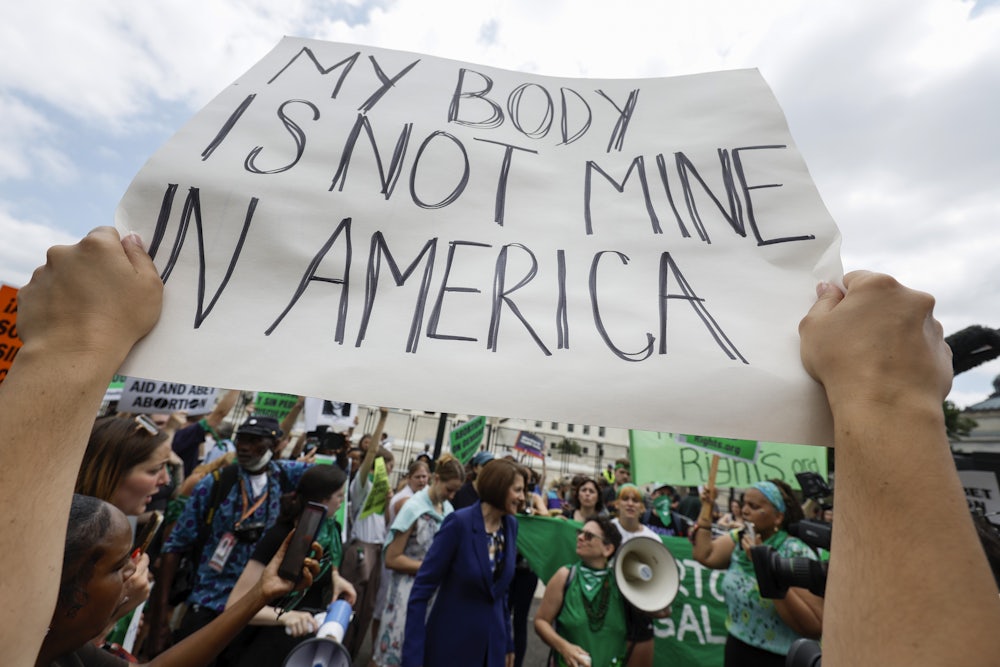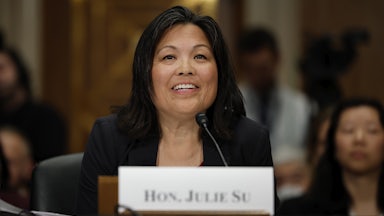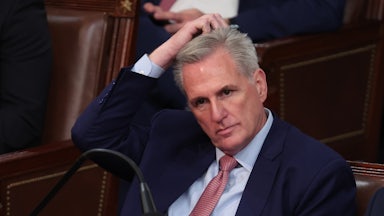Saturday marks one year since the Supreme Court overturned Roe v. Wade, a decision that widened the gulf between Americans who can acquire an abortion and those who cannot. In the time since Justice Samuel Alito wrote the opinion for the conservative majority in Dobbs v. Jackson Women’s Health Organization, the ability to obtain medication or procedural abortion has largely become predicated on which party controls a state’s government, as well as an individual’s personal and financial capacity to travel significant distances. The disjointed patchwork of abortion restrictions has increased confusion for providers and patients alike, exacerbating inequities in access affecting millions of Americans nationwide.
“I’ve been saying for a decade that we live in two different Americas as abortion providers,” said Amy Hagstrom Miller, founder and CEO of Whole Woman’s Health, which has abortion clinics in New Mexico, Minnesota, Illinois, Virginia, and Maryland—all of which border states with restrictive abortion policies. “It’s really crazy to live in a country where your rights depend on your zip code, and where you live.”
Abortion is banned altogether in 13 states, and seriously restricted in several others. Confusion over which laws should be enforced has fostered uncertainty in states like Arizona and Wisconsin, which still have nineteenth-century statutes on their books banning abortion. Other states, like Iowa, Ohio, and Wyoming, have seen their more restrictive abortion laws blocked by state and county courts. Meanwhile, several Democratic-led states have passed laws to expand or protect abortion rights, with states like Michigan and Colorado becoming “safe havens” for people seeking abortions from elsewhere.
Although the past year has been momentous for both supporters and opponents of abortion access, Roe’s fall had been telegraphed even before Alito’s draft decision in Dobbs was leaked to the press last May. For years, Republican-led states passed legislation restricting abortion access, although these laws were typically blocked in court. Donald Trump’s election buoyed abortion opponents, as did his appointing three more conservative justices to the nation’s highest court. In the summer of 2021, the Texas state legislature passed a law banning abortion after six weeks and sanctioning prosecutions of providers, and, more broadly, anyone who helped someone obtain an abortion. After the Supreme Court allowed that law to go into effect, abortion became functionally inaccessible in the state, with Texans traveling to neighboring states like New Mexico and Oklahoma to undergo the procedure.
“We were dealing with this manufactured health care crisis for months before the Dobbs decision came down,” said Zachary Gingrich-Gaylord, the communications director for Trust Women, an abortion provider with clinics in Oklahoma City and Wichita, Kansas.
Trust Women saw an influx of patients at its Oklahoma clinic after the passage of the Texas law. When the Sooner State banned abortion shortly before the Dobbs decision, many of the Texans who had been traveling to Oklahoma City looked to the Wichita clinic instead, as did the Oklahomans who no longer had access to abortion care. The Oklahoma City clinic, while still operational, no longer offers abortion care.
“We’re seeing nearly four times as many patients per month as we did prior to S.B. 8,” Gingrich-Gaylord continued, referring to the Texas law. “Now we’re well beyond 400 patients per month. Our phone call volume is outlandish. We’re receiving thousands of phone calls a day.”
The Texas law was a death knell for abortion rights, with Dobbs delivering the blow ensuring that millions would not have access to abortion care. The decision increased the importance of distance as one of the era’s great obstacles to abortion care. Whole Woman’s Health, which originated in Texas, closed down its clinics in the state after S.B. 8 was implemented. The organization moved its equipment from Texas to open a clinic in Albuquerque, New Mexico, which still primarily serves Texans. “I keep reminding people that the drive is actually more risky than the actual procedure,” Hagstrom Miller said. “Nobody should have to travel 13 and a half hours each way from Houston all the way to Albuquerque to have what is a very common and important medical procedure.”
Americans seeking abortions are disproportionately low-income, and a majority already have children, according to the Guttmacher Institute. It can be difficult for those seeking abortions to even afford traveling to another state—not to mention obtaining sufficient time off from work and finding child care.
“Those are the stories that are really disappearing from our narrative and our landscape, it’s the people who are denied access to abortion, who are forced to carry a pregnancy against their will. What’s going to happen to them, and their families, and their emotional health, their physical health, their economic health?” Hagstrom Miller asked. “What is going to happen to a generation of people?”
The Whole Woman’s Health clinic in New Mexico is not the only one increasingly serving out-of-state patients: Hagstrom Miller said that Whole Woman’s Health clinics in Virginia and Minnesota have seen dramatic increases. Minnesota has become a lonely island for abortion access in the Upper Midwest, surrounded by states where the procedure is banned or otherwise unavailable. North Dakota’s only abortion clinic, which was in Fargo, closed last July—then moved just a few miles to Moorhead, Minnesota.
“Now you’re self-righteous in North Dakota, and you’ve done nothing to provide preventative care, you’ve done nothing to provide contraceptive care, you’ve nothing to provide reproductive care, but you’re going to go ahead and let Minnesota absorb that for you,” said Minnesota Governor Tim Walz. He described a “massive increase” in patients from out of state traveling to Minnesota to obtain abortion care, which can, in turn, create lengthy wait times for such a time-sensitive procedure.
The largest contiguous region with limited or unavailable access is in the South, where Virginia may soon be the only state that provides abortion care with relatively limited restrictions. North Carolina—previously a safe haven for those seeking second-trimester abortions—recently passed a law banning abortion after 12 weeks, which goes into effect on July 1. Whole Woman’s Health currently has two Virginia clinics which offer procedural and medication abortions up to 18 weeks of pregnancy, and Hagstrom Miller said that they expect another surge in patients after the new North Carolina law goes into effect.
“We’re looking increasingly at the possibility of a map where access is pretty much gone in the South, and those regional blocs will make the effects of Dobbs much more acutely felt,” said Mary Ziegler, a professor of law at the University of California, Davis, who has written several books on the legal history of American abortion. “Even as there have already been harsh ramifications from Dobbs, I think that things are only going to get worse.”
In Ohio, a six-week abortion ban was briefly implemented after Dobbs, but a county judge blocked it in September. That law included a few exceptions for saving the life of the pregnant person. The state’s conservative-majority Supreme Court will review the judge’s order, and abortions remain legal in the state for up to 20 weeks. Adding to the confusion, Ohioans will vote in August on a ballot measure that would raise the threshold for amending the state constitution to 60 percent. One of the first proposals which would have to achieve that higher threshold would be an amendment to codify abortion rights, which is set to be on the ballot in November.
The swirling uncertainty around abortion access has complicated life for physicians like Maria Phillis, a spokesperson for the Society for Maternal-Fetal Medicine and a maternal-fetal medicine physician in Ohio. With the exceptions listed in the six-week ban, Phillis said, the decision of whether a patient is at risk depends less on the provider’s expertise and more on political calculations. That confusion extends to any state where abortion has been banned or severely restricted.
“It was previously [the patient’s] decision and your decision with them, by which I mean, you’re trying your best to counsel them through what they’re comfortable with in terms of their own risks to their life and health,” Phillis, an expert in high-risk pregnancies, told me. In the post-Dobbs era, however, physicians with “different risk thresholds” may not mention abortion care as an option for patients due to concerns about legality. Phillis described her experiences at an institution where abortions will not be offered unless patients are “literally on death’s door,” which has “has affected the ability to counsel patients appropriately” and “the ability to make sure patients are getting timely care.”
In the year since the Dobbs decision, there have been multiple stories nationwide of people being unable to obtain abortions even when their health or the health of the fetus was at risk. It has also affected care for ectopic pregnancies, life-threatening conditions which occur when a fertilized egg implants outside of the uterus. Even though an ectopic pregnancy is never viable, and treatment for the condition is technically separate from an abortion, some physicians still worry that they will be prosecuted if they treat it.
Even with explicit ectopic pregnancy protections, Phillis was concerned physicians would be “overly cautious” in diagnosing it. She knew providers in Tennessee, she said, who had sent their patients to obtain treatment for ectopic pregnancies out of state, before Tennessee passed a law in April allowing narrow exceptions for abortion care, including for ectopic pregnancies.
“I’m worried about the ability to provide care for our patients, and worried about having to stand there and make a decision about whether or not they’re sick enough or dying quickly enough to be able to securely provide a termination procedure,” Phillis said. “Having to potentially decide if someone is hemorrhaging fast enough to receive a termination procedure is not something that I want to think about.”
Moreover, there are connections between abortion care and miscarriage management: The treatment for a miscarriage in the first trimester is identical to that of a medication abortion. If abortion care is not taught in medical schools in states which restrict abortion, abortion rights advocates say it could hinder future doctors’ ability to treat miscarriages, as well as deter physicians from moving to those states. A recent study found that fewer medical school graduates applied for residencies in states which restricted or banned abortion in the wake of the Dobbs decision, with the greatest drop among OB-GYN residents. Another May survey found that nearly 58 percent of medical students were unlikely or very unlikely to apply for residencies in a state with abortion restrictions.
Beyond ongoing developments in the states, the future of abortion access on a federal level is uncertain. Congressional Republicans have recently shied away from legislation banning the procedure nationally, which would fail in the Democratic-controlled Senate even if it passed in the House. (Similarly, Republicans have blocked congressional Democrats’ efforts to codify the federal right to an abortion.) Several GOP presidential candidates have also sidestepped the question of whether they would support a federal abortion ban.
But there are ongoing efforts to restrict access to abortion in the courts: cases with abortion opponents trying to pull the abortion medication mifepristone from the market, for example, or attempting to use the nineteenth-century Comstock Act to declare that any abortion in the United States is illegal.
That law banned mailing contraceptives and drugs that induce abortions. The Comstock Act has been used in arguments against medication abortion, which make up more than half of all abortions in the U.S. today, as pills are often sent in the mail. Some abortion opponents also argue that, because all abortions involve equipment or medication that has at some point been sent through the mail, they are illegal.
“It does not require Congress to pass anything or the president to sign anything. It requires a court to interpret it a certain way, or a president to try to use the [Justice Department] to enforce the law,” Ziegler, the abortion law expert, said.
But even as abortion access across the country continues to shift and contract, providers say they will still work to provide care for the patients traveling, often across state lines and at great personal cost, to obtain the procedure or necessary medication. What was once a federal right is now perpetually in flux, and the only action available post-Dobbs is reaction. For physicians and clinics, that means continuing to fulfill their roles, even as lawmakers and courts further work to protect or restrict abortion care.
“The only constant is embracing the fact that people need access to safe abortion, and people deserve that access,” Hagstrom Miller said. “Where we can provide it and how we can provide it, that’s ever-changing and always up for debate and up for restriction, unfortunately. But the same amount of people in our communities still need care, and that’s a constant. And those of us who are dedicated to doing what we can to help them, that’s a constant.”










